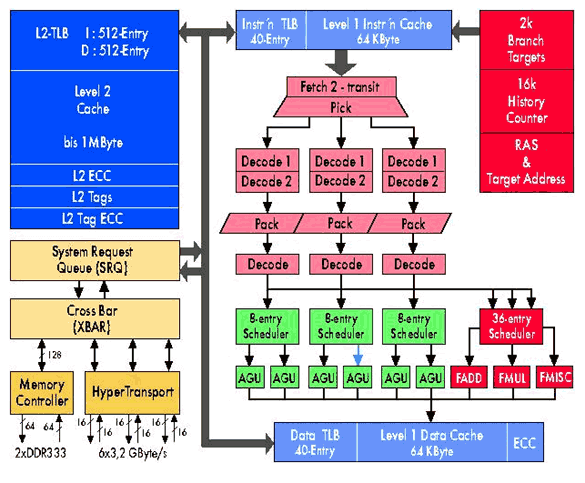AMD's Athlon 64 Has Arrived: the Athlon 64 FX and Athlon 64 (and Intel's P4 Extreme)
Athlon XP-64 Core: 95 Percent Athlon, Continued
The real innovations are in the details. At the heart of the CPU is a crossbar switch (XBAR), which manages the data streams between the memory controller, CPU core and the three HyperTransport ports. Compared to the Athlon 64, which is only meant for single-processor operation, the Opteron has a controller logic that allows multi-processor operation. Thus, when used for a server, up to eight Opterons can work together without a Northbridge. Furthermore, an SSE2-compatible unit has been added, which has twice the amount of registers (16) as the Intel P4. Fundamental changes are to be found at the command processing level: the Transition Look-aside Buffers (TLB) have been reworked for larger workloads (1000 entries max.). Basically, the more entries in the TLB, the less frequently the translation tables have to be accessed in system memory when transmitting the physical address.

The fundamental structure of the Hammer is not much different from the Athlon: the 3 integer and 3 floating point units have remained as unchanged as the three x86 decoders. The caches now have ECC circuitry. The crucial changes are in the details.
| CPU core | Hammer | Barton | Thoroughbred "B" |
|---|---|---|---|
| Wafer area (200 mm diameter) | 31416 mm² | 31416 mm² | 31416 mm² |
| Die area | 193 mm² | 101 mm² | 84 mm² |
| Process technology | 0.13 µm | 0.13 µm | 0.13 µm |
| Waste | 18 percent | 18 percent | 18 percent |
| Theoretical maximum yield | 122 pcs/wafer | 255 pcs/wafer | 306 pcs/wafer |
| Yield at 60% rate | 73 pcs/wafer | 153 pcs/wafer | 183 pcs/wafer |
| CPU core | Thoroughbred "A" | Palomino | Thunderbird |
|---|---|---|---|
| Wafer area (200 mm diameter) | 31416 mm² | 31416 mm² | 31416 mm² |
| Die area | 80 mm² | 128 mm² | 128 mm² |
| Process technology | 0.13 µm | 0.18 µm | 0.18 µm |
| Waste | 18 percent | 18 percent | 18 percent |
| Theoretical maximum yield | 322 pcs/wafer | 201 pcs/wafer | 201 pcs/wafer |
| Yield at 60% rate | 193 pcs/wafer | 120 pcs/wafer | 120 pcs/wafer |
Ultimately, that saves time so that commands require less speed. Compared to the Thoroughbred and Barton cores, the TLBs work with a smaller latency time, which, in turn, leads to an increase in speed. The branch prediction was also reworked in that the History Counter stores up to 16,000 entries (Athlon XP - 4,000). In order to accommodate higher clock speeds, AMD extended the pipeline of the Hammer to 12 stages - the old Athlon has only 10 stages, while the current Intel P4 (and Xeon) uses 20 stages. This allows the execution units to be supplied more quickly with consecutive commands, and does away with wait states.

A significant new feature: the extended 64 bit register.
Stay On the Cutting Edge: Get the Tom's Hardware Newsletter
Join the experts who read Tom's Hardware for the inside track on enthusiast PC tech news — and have for over 25 years. We'll send breaking news and in-depth reviews of CPUs, GPUs, AI, maker hardware and more straight to your inbox.
Current page: Athlon XP-64 Core: 95 Percent Athlon, Continued
Prev Page Athlon XP-64 Core: 95 Percent Athlon Next Page HyperTransport: A High-speed Bus Without DetoursMost Popular



